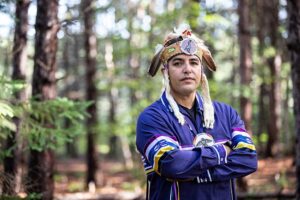Anishinabek Nation highlights importance of Indigenous science in Ontario classrooms

ANISHINABEK NATION HEAD OFFICE (July 13, 2022) – The Anishinabek Nation and the Kinoomaadziwin Education Body (KEB) are disappointed to learn of the Ministry of Education’s decision to remove the Indigenous Science Framework from the Ontario Curriculum. Together with Anishinabek educators, the Anishinabek Nation is willing to host a meeting with the Ministry of Education to advocate for the inclusion of these expectations for all students in Ontario.
“Connection with the land is central to Anishinabek knowledge systems,” says Anishinabek Nation Grand Council Chief Reg Niganobe. “Our ancestors are the original engineers of this place. Long before Canada flattened lands for railways and roadways, the Anishinabek traveled vast distances using the original highways of this land – waterways. They did so using an environmentally-friendly method of transportation through coexistence in the ecosystem.”
Universities, colleges, and schools across Ontario have been developing Indigenous STEM (Science, Technology, Engineering, and Mathematics) research and resources – and this step by the Ministry is not supported by the evolution of the field.
“Advocates for Anishinabek education have long fought for the recognition of our learning systems,” says Anishinabek Nation Southeast Regional Deputy Grand Council Chief James Marsden, Education portfolio holder for the Anishinabek Nation. “To remove this framework from the Ontario Curriculum is a regressive decision and dishonours our partnership.”
The Master Education Agreement between the self-governing Participating First Nations of the Anishinabek Education System, the Kinoomaadziwin Education Body, and the Government of Ontario signed in 2017, outlines a new path forward in education. This Agreement specifies that the parties involved will support collaboration in curriculum development and review processes.
“The Anishinabek Education System prioritizes Anishinabek culture, language, history, and knowledge in education,” says KEB Chairperson Phyllis Anderson. “The education system has made great strides in strengthening relationships with ministry and schoolboard partners. This decision creates barriers to the development and inclusion of reciprocal curriculum based in reconciliation.”
Article 15.1 of the United Nations Declaration on the Rights of Indigenous Peoples also states: Indigenous Peoples have the right to the dignity and diversity of their cultures, traditions, histories, and aspirations which shall be appropriately reflected in education and public information.
Anishinabek science, technology, engineering, and mathematics has existed since time immemorial on this land. It is imperative that Ontario and Indigenous partners work together in the spirit of reconciliation to build Indigenous STEM resources for a shared future.
“The fields of medicine and biology have been enriched by utilizing the teachings and minds of Indigenous traditional knowledge holders. From the first interactions with settlers and sharing of agricultural practices to biomedical research using compounds used for millennia — Anishinabek scientific knowledge is integral to building a shared knowledge base,” says M’Chigeeng Ogimaakwe Linda Debassige. “To have the Indigenous Science Framework removed from the Ontario Curriculum is both irresponsible and disrespectful not only to our ancestors and the deep history of our First Nations people, but to all of Ontario by going against the Calls to Action by the Truth and Reconciliation Commission of Canada calling on the inclusion of Indigenous contributions as part of school curriculum. We cannot erase the truth.”


